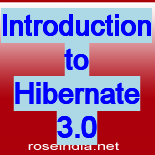Introduction to Hibernate 3.0



What is Hibernate?
Hibernate 3.0, the latest Open Source persistence technology at the heart of
J2EE EJB 3.0 is available for download from Hibernet.org.The
Hibernate 3.0 core is 68,549 lines of Java code together with 27,948 lines of
unit tests, all freely available under the LGPL, and has been in development for
well over a year. Hibernate maps the
Java classes to the database tables. It also provides the data query and
retrieval facilities that significantly reduces the development time.
Hibernate is not the best solutions for data centric applications that only uses
the stored-procedures to implement the business logic in database. It is most
useful with object-oriented domain modes and business logic in the Java-based
middle-tier. Hibernate allows transparent persistence that enables the
applications to switch any database. Hibernate can be used in Java Swing
applications, Java Servlet-based applications, or J2EE applications using EJB
session beans.
Features of Hibernate
- Hibernate 3.0 provides three full-featured query
facilities: Hibernate Query Language, the newly enhanced Hibernate
Criteria Query API, and enhanced support for queries expressed in the native
SQL dialect of the database.
- Filters for working with temporal (historical),
regional or permissioned data.
- Enhanced Criteria query API: with full support for
projection/aggregation and subselects.
- Runtime performance monitoring: via JMX or local
Java API, including a second-level cache browser.
- Eclipse support, including a suite of Eclipse
plug-ins for working with Hibernate 3.0, including mapping editor,
interactive query prototyping, schema reverse engineering tool.
- Hibernate is Free under LGPL: Hibernate can be used to develop/package
and distribute the applications for free.
- Hibernate is Scalable: Hibernate is very performant and due to its
dual-layer architecture can be used in the clustered environments.
- Less Development Time: Hibernate reduces the development timings as it
supports inheritance, polymorphism, composition and the Java Collection framework.
- Automatic Key Generation: Hibernate supports the automatic
generation of primary key for your.
- JDK 1.5 Enhancements: The new JDK has been
released as a preview earlier this year and we expect a slow migration to
the new 1.5 platform throughout 2004. While Hibernate3 still runs perfectly
with JDK 1.2, Hibernate3 will make use of some new JDK features. JSR 175
annotations, for example, are a perfect fit for Hibernate metadata and we
will embrace them aggressively. We will also support Java generics, which
basically boils down to allowing type safe collections.
- EJB3-style persistence operations: EJB3 defines the create()
and merge() operations, which are slightly different to Hibernate's
saveOrUpdate() and saveOrUpdateCopy() operations.
Hibernate3 will support all four operations as methods of the Session
interface.
- Hibernate XML binding enables data to be
represented as XML and POJOs interchangeably.
- The EJB3 draft specification support for POJO persistence and annotations.
Detailed tutorials are available at Rose India Hibernate Tutorial.
